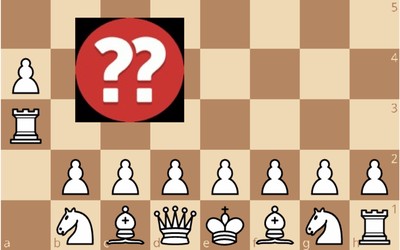
Photo by Lance Reis on Unsplash
5-minute game: More like Wilhelm SteinBLITZ!
The Queen goes to war early in the Scotch Game with 4. ... Qh4!?Playing slow time controls is a great idea for lots of reasons. In my quest to add about 100 ELO to my Rapid rating, I'm hoping to use an upcoming trip as an excuse to play some 15+10 games to see how I do compared to my recent 10-minute play. Slow play. Careful play. The kind of games where you really take time to understand what you're trying to achieve and work to make it happen. This is definitely the right path towards building better habits and growing as a chess player.

But, LOOK - Blitz is fun. And given that I'm kind of struggling with fast play in the Rapid time controls, I actually think that playing Blitz and not worrying so much about my rating might be a way to get me moving faster and trying to build up that pattern recognition everyone always talks so much about. I also try to use it sometimes as an opening lab - a place to try out lines I'm curious about to see what happens in a bunch of different games fairly quickly. This has been a useful way to grow my opening repertoire over the past year, leading to me adopting approaches I like for the Vienna Game, The King's Gambit, and other openings I used to find problematic. The game I've got for you here begins with an opening variation I've grown quite fond of after lots of test runs in 5+0 play (my favorite Blitz format): The Steinitz Variation of the Scotch Game.
This opening arises after the usual 1. e4 e5, 2. Nf3 Nc6, 3. d4 exd4, 4. Nxd4 Qh4!?

I would really like to refer to this as the "YAASSS QUEEN" variation, but I'm guessing no one else would go for it. Also, it would do a great disservice to Wilhelm Steinitz, first World Chess Champion and absolutely boss chess theoretician. As a kid, I had a book about the chess champions that led me to write Steinitz off as boring compared to my favorites (Capablanca is still top-tier for me), but as I learn more about him and some of his contributions to the opening, the man turns out to be a beast. Still, that !? after this Queen move is probably well-deserved: The line 5. Nc3 Bb4, 6. Be2 Qxe4, 7. Nb5 Bxc3+, 8. bxc3 Kd8, 9. 0-0 leaves White in a decent spot. The threat of the fork on c7 forces the Black King to give up castling rights, and the extra pawn Black got for their trouble isn't any kind of guarantee. But y'know what? It isn't a guarantee for either side and this is one of those openings that I've found lots of fun to play as a result. It can get weird and sharp very quickly and I'd usually rather play that kind of game if at all possible.
The other thing is that if you're Black in this opening (which I was) there is a really good chance your opponent doesn't play that 6. Be2 move at all. Instead, they often do something a little more like what my opponent did: 5. Nc3 Bb4, 6. Nxc6.

I see this capture a lot, often right after 4. ... Qh4!? It's not a great idea, as it opens a window for Black to nab a pawn in the center without messing up the King's plans at all. Here, I take a shot at this with 6. ... Bxc3+ 7. bxc3 Qxe4+, 7. Qe2 Qxe2+, 8. Bxe2 dxc6.

I like this position a lot and have had decent results with it. Black is a pawn up, castling to either side is quick to realize, and while White has the Bishop pair, it's not too bad for Black to use that extra pawn to jam up at least one of them. Things aren't much different if White chooses to block with the light-squared Bishop instead of the Queen, but for whatever reason I nearly always see White opt for the Queen trade.
Regardless, this is a situation where I very much have a clear sense of what I want to do next and usually find ways to keep the game going my way by keeping up my own momentum, using the extra material, and putting questions to White to keep the initiative as much as I can.
In this game, some themes I'm familiar with showed up - (1) a Queenside castle for me after developing the Bishop (White playing Rd1 can make this annoying but also isn't something I see much), (2) White threatens my a-pawn, which isn't an empty threat even with the potential to try trapping it with b7-b6: A subsequent Ba6+ makes things messy and annoying. (3) Develop the Knight with the natural-looking Nf6. I add a questionable c5 push into the mix, thinking this makes the dark squares inhospitable for one of the White Bishops. As it turns out, this weakens my advantage substantially, starting with the Ba6+ that I knew was a pain to deal with! Ah well - lesson learned in the post-mortem and hopefully remembered for later games both fast and slow. We're here after 15 moves:

The trouble of course is that I've given up a pawn, which puts us more or less right back at 0.0: Bxc5 uses the Rook's pin to erase that dark-square coverage I thought I'd established. My opponent over-commits to the idea that the a-pawn can get in the mix and make trouble, though, and doesn't see this tactic. He pushes it forward (which I am not at all worried about) while I centralize my knight so that I can threaten and take the dark-squared Bishop, after which I can park a Rook on the 2nd rank. That a-pawn gets in to take the b-pawn, but I just retake with one of those doubled c-pawns and all is well on the Queenside for now.

He decides to hassle that Rook on the 2nd rank with 20. Rd3, which is not a great plan. I could just snatch up that pawn on c2, but for some reason I decide to go with a sort of X-ray attack using 20. ... Rd8. This was one of those cases where I think I was relying on a vague memory that sort of Rook sandwich is often the beginning of some sneaky tactic. Here, it would've been better to stop trying to be clever and just take the extra pawn, but it's not a catastrophe either. We trade the Bishops off (after another easy pawn capture) and now it's really just down to flexing the Queenside pawn majority. The rest of the game is pretty straightforward - the pawns go marching one by one until the Rook is squeezed too tight and White resigns.

Again, not an amazing game with incredible brilliancies, but as a guy who often gets put on my back foot when an opponent forces me into lines I don't know well, the Steinitz Variation feels like a chance to make White deal with the game on my terms a little bit. This particular line (which does depend on the early missteps I described by White) also keeps things very open and clear for Black, which often means even if I make some errors (like I did here), I can usually recover and force the other player to play some chess to try and get the W.
From the Blitz-as-lab perspective, I think there is a funny benefit to analyzing mistakes in my Blitz games instead of my Rapid games: I sort of care less about them and don't take the loss so personally, which makes the post-mortem a little more fun to engage in. This is just one of those mental toughness things, I know, but I'm a grumpy loser, especially after Rapid losses that I hoped would help me climb the rating ladder a bit instead! In Rapid, that pawn move might have cost me the game - in Blitz, the same inaccuracy (or even blunder) might still get you a win, after which you can scratch your chin thoughtfully and analyze your errors safe in the knowledge that it didn't cost you this time because the other player didn't see it either.
I sort of wonder if this is a thing other players find to be true about post-mortem analysis. There is this excellent saying "I either win, or I learn." which sounds great, but is not at all how I actually respond to losses if I'm being honest. In my case, i either win, or I scowl for a while as I look over the engine analysis. That scowl doesn't seem to support as much worthwhile use of post-game analysis as the more even keel I can maintain if I won a Blitz game despite blundering. For tonight, it was fun to ring the changes on a slightly off-beat approach to the Scotch Game and if I'm being fully transparent, it didn't escape my notice that this nudged my Blitz rating up over the century line from 1293 to 1301 over at chess.com.
Of course I care. Just a bit, though, right? Full game below in case you want to explore a little on your own.
More blog posts by NDpatzer

Science of Chess: A g-factor for chess? A psychometric scale for playing ability
How do you measure chess skill? It depends on what you want to know.
Science of Chess (kinda?): Viih_Sou's 2. Ra3 and a modest research proposal
Take the 2. Ra3 Challenge! For Science!
Science of Chess - Achtung! Einstellung!
Pattern recognition is great, but the Einstellung effect can turn a master into a patzer (sort of).
